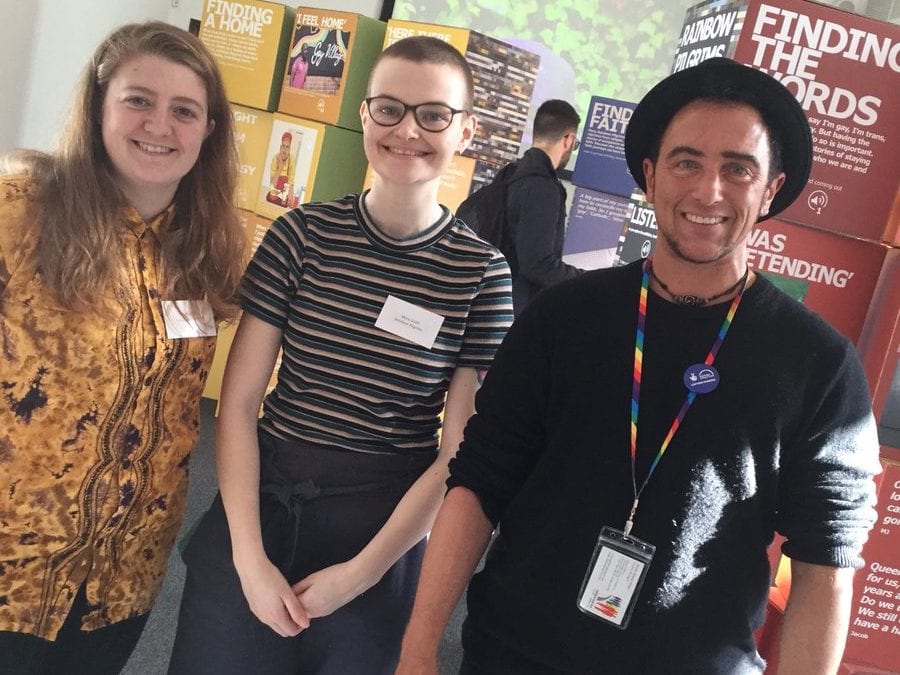“The meaning of a home to me is where you can hear laughter, where you can live happily, where you can feel safe.” – Muhammad, interviewee
original post:https://marysscott.wordpress.com/2019/02/21/the-meaning-of-home/
I’m Mary, currently studying on Goldsmith’s Queer History MA programme and partaking in a placement at Liberal Judaism, in fair Fitzrovia, as part of a module on Queer Public History. I am into my fourth week and fifth placement day at as I write this – fifth day being because last Saturday was spent assisting with an exhibition of the Rainbow Pilgrims project, a collection of LGBTQI migrants’ oral histories. Fortuitously, the exhibition was already scheduled to show in my home-city of Cambridge, so it was easy for me to wake up at 7.30am to start setting up.
Well. ‘Easy’ might be pushing it (I am not a morning person), but I was glad that I managed to get out of bed on time, as the 30 pop-up boxes that comprised the exhibit required quite a bit of manoeuvring, even with four of us working on them.
The Rainbow Pilgrim’s project was started in 2016, after two years’ worth of funding were obtained from the National Lottery Heritage Fund. Over the next two years, a team of volunteers were trained to collect the oral histories of LGBTQI migrants to the UK, in the first project of its kind.
The project was also notable in its inclusion of often forgotten members of the queer diaspora, such as intersex people and the Gypsy Roma Traveller (GRT) community. This effort to promote inclusivity amongst a transnational focus is an aspect of the exhibit that I really like. It was also the foundation of several interesting dialogues that arose with members of the public on Saturday.
Choosing to include ‘Q’ (Queer) and ‘I’ (Intersex) in the titular acronym of the project was a deliberate decision. Many migrants’ stories pivot around the unstable point of identity experienced when growing up in worlds that don’t ascribe language or space to queer identities. A popular narrative is that once migrants have made their ‘journey to the West,’ their identities are graciously accepted into our free, tolerant society and Everything Is Okay. One vital thing that the oral histories of the project emphasise is that this is often not the case.
Although we have LGBT+ rights inculcated in law, the complicated intersections between faith, race, gender and sexual orientation present their own set of challenges for anyone who doesn’t fit within a prescribed set of societal lines. Therefore, the deliberate and thought-out inclusion of terms intended to include as many of the community as possible is important to a project that aims to promote intersectionality.
Over the course of the exhibit I was asked more than once what ‘all the letters’ stood for. Several people expressed their disapproval for labels. One man suggested we just put the entire alphabet up there, lest we offend someone by omission. This might paint the people in question in a bad light; none of the comments were aggressive or overly confrontational, but they did bring home to me the difficulty in navigating the nuances of identity in a world that resists change, often on the basis of the very complexity that makes specification important.
Even within historically erased groups, visibility is relative: those with power, privilege and social standing are inevitably the people who most often write history. One of the people included in the project was Henry Chapman, a queer member of the GRT community who did incredible work for the visibility and advocation of his community. His interview featured in ‘Another Story,’ a film about the making of the exhibition that was screened during the exhibit. It was a strange experience to spend six hours in a room with his voice playing on loop, all the while knowing that three weeks ago he sadly passed away.
When I first started at placement I was mainly charged with promoting Liberal Judaism’s three LGBT+ heritage projects – Rainbow Pilgrims, Twilight People and Rainbow Jews – on social media. Although I enjoyed formulating posts and communicating with the public, there was a part of me thinking, ‘Does this relate to history?’ Coming from an archiving background inclines me to associate history with dusty documents and old books. It can be easy to forget all about the people who wrote and read them.
I think it was this weekend that it clicked for me that telling people’s stories is sharing their histories, and by giving people a voice and a space – even if the voice is staticy and the space is small – you assert their existence. This is why the ‘+’ and the ‘Q’ and the ‘I’ and the GRT community are important. If history is defined by the past, memorialisation takes place in the present, and the actions inspired by the process of memory provide traction for future changes. All of the projects that I’m promoting as part of my placement consist of individual histories woven together to form narratives as unique as they are universal.
by Mary Scott
Featured image:
From left to right: Molly (Encompass Cambridge), myself and Shaan (Liberal Judaism)


